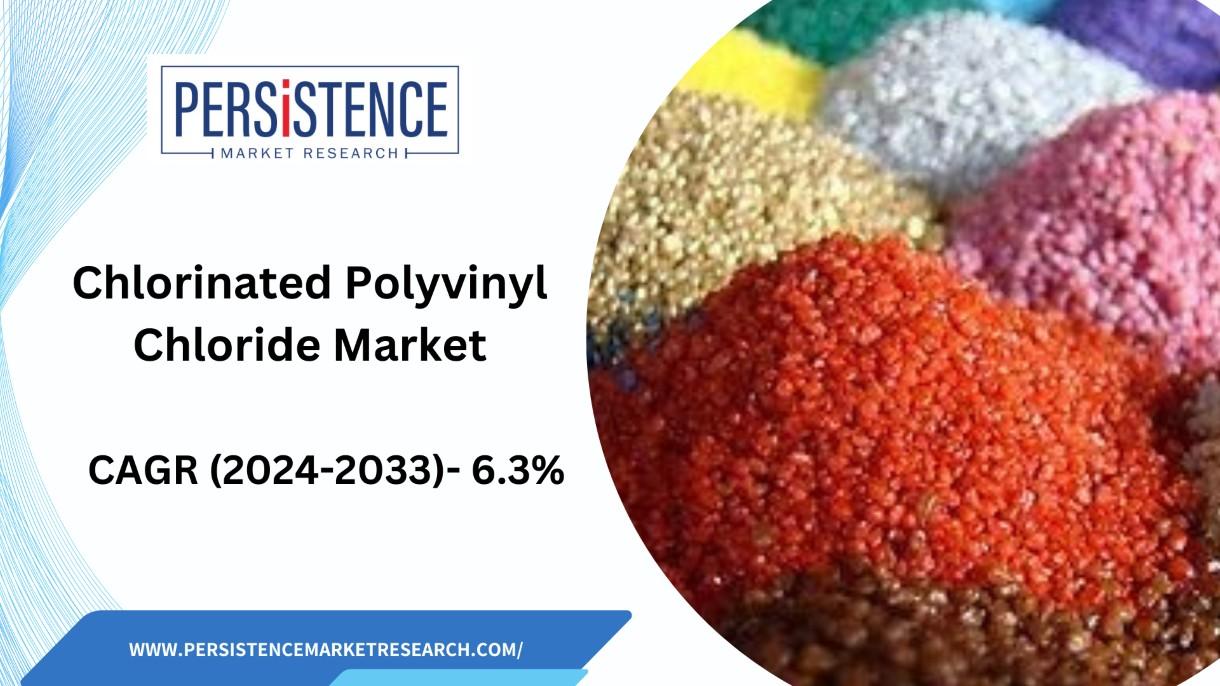Chlorinated Polyvinyl Chloride (CPVC) Market: Comprehensive Segmentation
Analysis
The global chlorinated polyvinyl chloride (CPVC) market is expected to grow significantly from an estimated US$4.35 billion in 2024 to US$7.1 billion by 2033, with a projected compound annual growth rate (CAGR) of 6.3%. This growth is driven by several factors, including increasing awareness of CPVC's benefits, its widespread adoption in piping systems for hot and cold water distribution across residential, commercial, and industrial sectors, and its integration into fire sprinkler systems. CPVC, a thermoplastic derived from chlorinated polyvinyl chloride resin, offers enhanced chemical resistance and durability, making it suitable for high-temperature applications in plumbing, industrial processes, and infrastructure development. The market's expansion is further supported by its ease of installation, low maintenance needs, and long service life, making it a preferred choice among builders and contractors. Additionally, CPVC's versatility extends to applications in industrial coatings, electrical conduits, and automotive components, positioning it as a sustainable and reliable alternative amid increasing environmental regulations and concerns.

Overview of CPVC Market Segmentation
Chlorinated Polyvinyl Chloride (CPVC) is segmented based on several factors, including application, end-user industry, and region, to address specific market requirements and preferences. The segmentation analysis provides insights into the diverse applications and growth opportunities within the CPVC market.
1. By Application
a. Plumbing Systems: CPVC pipes and fittings are extensively used in residential, commercial, and industrial plumbing systems due to their corrosion resistance, durability, and ease of installation. The demand for CPVC in plumbing applications is driven by infrastructure development, urbanization, and the replacement of aging piping systems.
b. Industrial Piping: CPVC is crucial in industrial applications where resistance to corrosive chemicals and high temperatures is essential. Industries such as chemicals, pharmaceuticals, and manufacturing rely on CPVC piping systems to ensure operational efficiency and safety.
c. Fire Protection Systems: CPVC's fire-retardant properties make it suitable for fire protection systems in buildings, ensuring reliable water distribution during fire emergencies. CPVC pipes and fittings meet stringent fire safety standards, driving their adoption in commercial and residential constructions.
d. Others: CPVC finds applications in diverse sectors, including agriculture, automotive, and electronics, where its properties such as chemical resistance and mechanical strength offer significant advantages over conventional materials.
2. By End-User Industry
a. Construction: The construction industry is a major consumer of CPVC, utilizing it for plumbing, HVAC systems, and fire protection in residential, commercial, and institutional buildings. Infrastructure development and urbanization fuel the demand for CPVC products in the construction sector.
b. Chemicals & Pharmaceuticals: CPVC is integral to the chemicals and pharmaceutical industries, where it is used for transporting corrosive chemicals and maintaining process integrity. The reliability and durability of CPVC piping systems support safe and efficient operations in these industries.
c. Manufacturing: Manufacturing sectors rely on CPVC for industrial piping solutions that withstand harsh operating conditions, ensuring product quality and operational reliability. CPVC's resistance to chemicals and high temperatures makes it a preferred choice in manufacturing processes.
3. By Region
a. North America: North America dominates the CPVC market, driven by infrastructure development, stringent regulatory standards, and technological advancements in piping materials. The region's construction and industrial sectors contribute significantly to CPVC demand.
b. Europe: Europe's CPVC market benefits from regulatory support for sustainable construction materials and infrastructure modernization initiatives. The adoption of CPVC in residential and commercial applications is growing due to its environmental compliance and performance advantages.
c. Asia Pacific: Asia Pacific is witnessing rapid urbanization, industrialization, and infrastructure investments, driving CPVC market growth. Countries like China and India are key contributors to regional demand for CPVC in construction and industrial sectors.
d. Latin America: Latin America's CPVC market is expanding with infrastructure development and industrial growth. CPVC's resilience in harsh environmental conditions makes it suitable for diverse applications across the region's construction and industrial sectors.
e. Middle East & Africa: The Middle East and Africa utilize CPVC for infrastructure projects, including oil and gas, utilities, and commercial developments. CPVC's durability and fire safety properties are critical in these regions' construction and industrial applications.
Key Growth Drivers and Challenges
Drivers: Infrastructure development, industrial expansion, regulatory compliance, and technological innovations in CPVC formulations drive market growth.
Challenges: Competition from alternative materials, supply chain disruptions, cost sensitivity, and regulatory complexities present challenges to CPVC market expansion.
Future Trends
1. Technological Advancements: Continued innovation in CPVC production processes will focus on enhancing material properties, such as temperature resistance and mechanical strength. This will expand CPVC's applications into new sectors and improve its performance in existing uses like plumbing and industrial piping.
2. Sustainability Initiatives: Increasing emphasis on sustainability will drive the adoption of eco-friendly CPVC manufacturing practices, including recycling and reducing environmental impact. This trend responds to growing regulatory pressures and consumer demand for greener building materials.
3. Market Expansion in Developing Regions: The Asia-Pacific region, particularly China and India, will remain pivotal as rapid urbanization and infrastructure development spur demand for CPVC in construction and industrial applications. Latin America and the Middle East & Africa are also expected to contribute to market growth.
4. Diversification of Applications: CPVC's chemical resistance and durability will lead to its adoption in diverse applications beyond traditional plumbing and piping, including medical devices, automotive parts, and electronics, offering new avenues for market expansion.
5. Focus on Cost Efficiency: With fluctuating raw material costs, manufacturers will focus on cost-effective production methods and efficient supply chain management to maintain competitiveness in the global market.
These trends indicate a dynamic future for the CPVC market, driven by innovation, sustainability, and expanding global demand across various industrial and consumer sectors.
